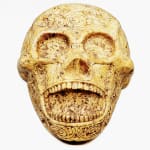Taíno 'Macorix' Decorated Skull, AD 1400 - AD 1500
Jasper
31 x 23.5 x 15.5 cm
12 1/4 x 9 1/4 x 6 1/8 in
12 1/4 x 9 1/4 x 6 1/8 in
CC.45
Further images
-
(View a larger image of thumbnail 1
)

-
(View a larger image of thumbnail 2
)

-
(View a larger image of thumbnail 3
)

-
(View a larger image of thumbnail 4
)

-
(View a larger image of thumbnail 5
)

-
(View a larger image of thumbnail 6
)

-
(View a larger image of thumbnail 7
)

-
(View a larger image of thumbnail 8
)

-
(View a larger image of thumbnail 9
)

When the Columbus expedition arrived in the New World in AD 1492, the islands of the Caribbean were already inhabited by the complex Taíno culture. The Taíno probably emigrated to...
When the Columbus expedition arrived in the New World in AD 1492, the islands of the Caribbean were already inhabited by the complex Taíno culture. The Taíno probably emigrated to the major islands of the Caribbean from Central America some 2,500 years ago, supplanting the native pre-pottery foraging peoples through disease or violence. The Taíno were ruled by male chiefs, called caciques, who inherited their position through matrilineal succession. Below them were nobles (nitaínos) and commoners (naborias). Taíno women engaged in agriculture, while the men fished and hunted. They developed the use of poisoned arrowheads for hunting.
Taíno religion centred around the worship of spirits known as zemís. A zemí was an ancestral spirit, as opposed to a forest spirit or opia, and lived in a statue or figure kept in the round temples known as bohíos. Alongside zemís in the form of animals and humans, human skulls were also kept. The Taíno believed that the spiritual power of a human was housed in the head, and particularly the face. The skulls of ancestors therefore retained some of the spiritual essence of the individual. However, human skulls do not always have the best standard of preservation, and later Taínos (AD 1000 to AD 1500) chose to carve skulls out of stone to replace them. These skulls became known as ‘Macorix heads,’ as many of them have been found near San Pedro de Macorís, in the Dominican Republic.
This skull is a particularly fine example. Anatomically, it is a very close representation of the human skull, with realistic proportions of the mouth, nose, and eye cavities. One might wonder, given its clear anatomical correctness, whether this is a ‘portrait’ of an individual’s skull. The skull has prominent cheekbones, a square jaw, a flat forehead with a clear supraorbital ridge, and a bat-like nose. The mouth is open, exposing two rows of finely-carved teeth. The teeth are all approximately the same size, with little differentiation between the incisors, canines and molars. This, however, is not necessarily a flaw of the artist. In many ancient societies, where pollutants like grit and sand often contaminated foodstuffs and where cutlery was not used to chop up food before consumption, the wear on teeth was much greater than in modern times, resulting in a more uniform appearance of the teeth, The skull is slightly larger than life-size, and has intricate maze-like geometric motifs on the forehead, around the ear, and along the jaw. While fearsome in appearance, it should be noted that this figure represented the ancestral line of the Taíno village, incorporating in these elements the essence of the Taíno culture and the history of the people.
Taíno religion centred around the worship of spirits known as zemís. A zemí was an ancestral spirit, as opposed to a forest spirit or opia, and lived in a statue or figure kept in the round temples known as bohíos. Alongside zemís in the form of animals and humans, human skulls were also kept. The Taíno believed that the spiritual power of a human was housed in the head, and particularly the face. The skulls of ancestors therefore retained some of the spiritual essence of the individual. However, human skulls do not always have the best standard of preservation, and later Taínos (AD 1000 to AD 1500) chose to carve skulls out of stone to replace them. These skulls became known as ‘Macorix heads,’ as many of them have been found near San Pedro de Macorís, in the Dominican Republic.
This skull is a particularly fine example. Anatomically, it is a very close representation of the human skull, with realistic proportions of the mouth, nose, and eye cavities. One might wonder, given its clear anatomical correctness, whether this is a ‘portrait’ of an individual’s skull. The skull has prominent cheekbones, a square jaw, a flat forehead with a clear supraorbital ridge, and a bat-like nose. The mouth is open, exposing two rows of finely-carved teeth. The teeth are all approximately the same size, with little differentiation between the incisors, canines and molars. This, however, is not necessarily a flaw of the artist. In many ancient societies, where pollutants like grit and sand often contaminated foodstuffs and where cutlery was not used to chop up food before consumption, the wear on teeth was much greater than in modern times, resulting in a more uniform appearance of the teeth, The skull is slightly larger than life-size, and has intricate maze-like geometric motifs on the forehead, around the ear, and along the jaw. While fearsome in appearance, it should be noted that this figure represented the ancestral line of the Taíno village, incorporating in these elements the essence of the Taíno culture and the history of the people.








